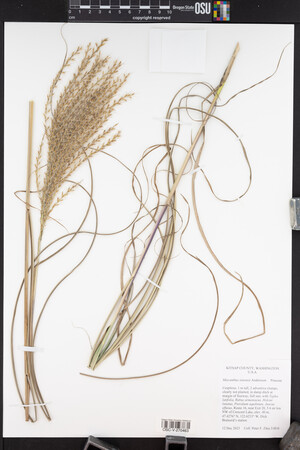Miscanthus sinensis
|
|
|
|
Family: Poaceae
Chinese Silver Grass, more...Eulalia
[Erianthus japonicus (Trin.) P. Beauv., moreEulalia japonica Trin., Eulalia japonica var. gracillima (Hitchc.) Grier, Miscanthus boninensis Nakai ex Honda, Miscanthus sinensis f. gracillimus (Hitchc.) Ohwi, Miscanthus sinensis f. sinensis Andersson, Miscanthus sinensis f. variegatus (Beal) Beetle, Miscanthus sinensis f. zebrinus (Beal) Beetle, Miscanthus sinensis var. condensatus (Hack.) Makino, Miscanthus sinensis var. gracilliumus Hitchc., Saccharum japonicum Thunb.] |
Plants cespitose, forming large clumps, with short, thick rhizomes. Culms 60-200 cm tall, 3-7 mm thick below. Leaves predominantly basal; sheaths mostly glabrous, throats pilose; ligules 1-2 mm; blades 20-70 cm long, 6-20 mm wide, midveins conspicuous abaxially, 1-2 mm wide, whitish. Panicles 15-25 cm long, 8-28 cm wide, dense to loose, usually with more than 15 branches; rachises 6-15 cm, 1/3- 2/3 as long as the inflorescences; branches 8-15(30) cm long, about 10 mm wide, sometimes branched at the base; internodes 4-8 mm, glabrous. Shorter pedicels 1.5-2.5 mm; longer pedicels 3.5-6 mm, slightly recurved at maturity. Spikelets 3.5-7 mm, lanceolate to lance-ovate; callus hairs 6-12 mm, to twice as long as the spikelets, white, stramineous to reddish. Glumes subequal; lower glumes 3-veined, ciliolate on the margins; upper glumes 1-veined; awns of upper lemmas 6-12 mm, geniculate below. 2n = 38, 40, and dysploids from 35-42. Miscanthus sinensis is native to southeastern Asia. It is frequently cultivated in the United States and southern Canada, and is now established in some parts of the United States. Approximately 40 forms and cultivars are available, some having white-striped leaves, others differently colored callus hairs and, consequently, differently colored panicles. Perennial tufted herb, bearing short and thick rhizomes 0.6 - 2.25 m tall Leaves: mostly basal, the open sheaths softly hairy on the throats but otherwise hairless. The ligules are 1 - 2 mm long, flat-topped, membranous, and lined with hairs along the margins. The blades are 20 cm - 0.7 m long, 0.6 - 2 cm wide, flat, and have prominent whitish midveins beneath. Inflorescence: terminal, branched (panicle), 15 - 25 cm long, 8 - 28 cm wide, with the main axis (rachis) 6 - 15 cm long, and the branches 8 - 30 cm long and 10 mm wide. Fruit: a caryopsis. Culm: erect, 0.6 - 2 m tall, 3 - 7 mm across near the base. Spikelets: either stalkless or stalked, 3.5 - 7 mm long, lance-shaped to narrow egg-shaped. Glumes: nearly equal, the lower glume three-veined and lined with hairs along the margins, the upper glume single-veined. Florets: either sterile (lower florets) or bisexual (upper florets). The lemma has a 6 - 12 mm long awn that is bent near the base. Similar species: Miscanthus sacchariflorus differs from Miscanthus sinensis because its lemmas are unawned or short-awned. Flowering: September to October Habitat and ecology: Introduced from Asia, this species rarely escapes from gardens, often into waste ground. Occurence in the Chicago region: non-native Etymology: Miscanthus comes from the Greek words miskos, meaning stem, and anthos, meaning flower. Sinensis means Chinese. Author: The Morton Arboretum Robust, 2-3 m, in large tufts; lvs elongate, to 1 m, ca 1 cm wide, scabrous-margined; racemes simple, rather closely approximate, forming a fan-shaped panicle; glumes narrow, 3-4 mm, subtended and equaled or shortly exceeded by a ring of long silky hairs; lemmas 2-3 mm, the fertile one with an awn 6 mm; 2n=35-57. Native of China, cult. for ornament and occasionally escaped. Autumn. Gleason, Henry A. & Cronquist, Arthur J. 1991. Manual of vascular plants of northeastern United States and adjacent Canada. lxxv + 910 pp. ©The New York Botanical Garden. All rights reserved. Used by permission. From Flora of Indiana (1940) by Charles C. Deam Indiana Coefficient of Conservatism: C = null, non-native Wetland Indicator Status: UPL |
|
|
|











































































